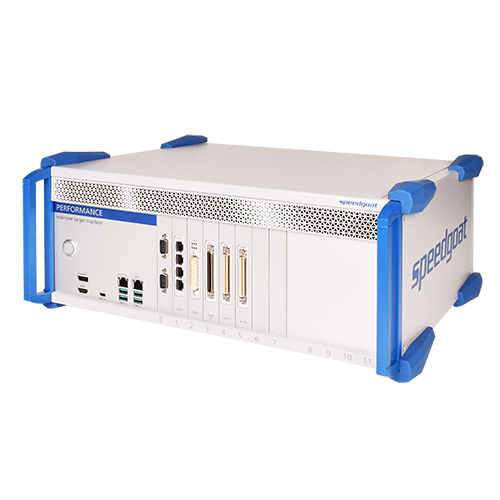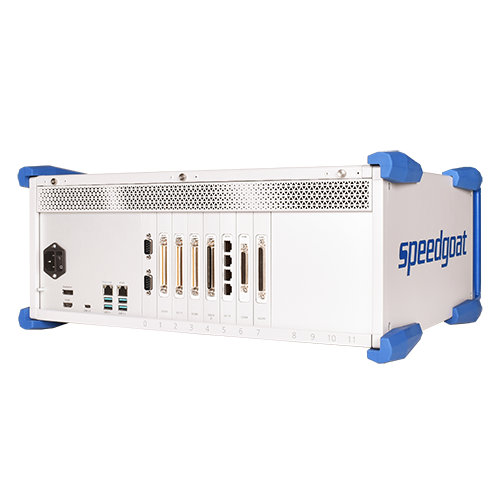Performance Real-Time Target Machine
The Performance real-time target machine is Speedgoat’s mainstay target computer for office and lab use and can be placed on a desk or installed in a rack.
It is used in a broad range of application areas and industry sectors, such as vision and image processing, rapid control prototyping (RCP) or plant simulation with hardware-in-the-loop (HIL).
MathWorks software products are optimised to guarantee the best real-time performance, workflow integration and usability with Simulink Real-Time™ and Speedgoat target machines.
Speedgoat builds and optimises its target machines for use with Simulink Real-Time, as well as guaranteeing that each target machine is configured to meet specific requirements, including model complexity, sample rate, data storage, I/O, and environmental.
Every target machine comes with the Speedgoat library, providing Simulink driver blocks to support all interfaces and simple Simulink models to get up and running quickly.
Real-time target machines with Intel i3, i7 and Xeon CPU options with clock speed up to 4 GHz are made for hard real-time execution, where reaction times are fully deterministic. With multicore, multi-target, and FPGA-based hardware and software technologies provided by MathWorks and Speedgoat closed-loop sample rates up to the MHz range are achievable.
- Concurrent real-time application execution on multiple cores, target machines, and FPGAs
MathWorks software (including Simulink Real-Time, MATLAB Coder, Simulink Coder, and HDL Coder), Speedgoat real-time target machines and FPGA-based I/O modules allow concurrent execution of your real-time application created from Simulink models on multiple cores, target machines, and FPGAs.
- Multicore execution
The Performance real-time target machine comes with multicore Intel CPUs ranging from two to eight cores. This combined with Simulink Real-Time technology to distribute performance optimised models to multiple cores allows application execution times to be significantly reduced, especially for complex models.
- Multi-target execution
There are multiple options to synchronise Speedgoat real-time target machines. FPGAs or analog I/O modules can be used to receive interrupt signals for a common trigger, or shared memory can be implemented using dedicated I/O modules. These options provide ultra-low latency and deterministic data exchange in addition to sub-microsecond synchonisation. Alternatively, multi-node synchronous operation can be achieved using time-based methods including industrial or precision time protocols.
- FPGA co-execution
AMD FPGA-based I/O modules from Speedgoat, combined with HDL Coder from MathWorks, and x86/FPGA co-execution functionality provided by Simulink Real-Time, provide a seamless workflow to automatically generate, run, verify, and validate parts of your real-time application on one or several FPGAs.
Using powerful high-bandwidth bus solutions, connecting several FPGA-based I/O modules, Simulink designs can be partitioned to execute across multiple FPGAs. This enables execution of very complex applications requiring hundreds of analog and digital I/O channels at closed-loop sample rates up to several MHz.
The Performance real-time target machine supports a vast range of I/O to connect with your hardware. It comes with some default on-board I/O, additional interfaces can be added by the installation of alternative I/O modules. Up to eleven I/O modules can be installed directly into the target machine and I/O expansion options are available if required.
I/O Modules
Speedgoat I/O modules offer an easy, flexible way of adding a large variety of I/O to your real-time target machine.
On-board I/O Connectivity
The following I/O comes pre-installed as standard in every Performance real-time target machine:
- 1 x Ethernet port supporting XCP Slave and Host-Target communication
- 1 x Ethernet port supporting EtherCAT Master, real-time UDP, TCP/IP, XCP Master, Modbus TCP and many more.
- 2 x RS232/422/485 at front
- 4 x USB 3.1 Gen 2 Type A at front
- 1 x USB 3.1 Gen 2 Type C at front
The enclosure of the Performance real-time target machine is manufactured from high-grade aluminum which is ideal as it is strong, very light, corrosion resistant, conducts heat and is non-magnetic. The front is anodized while all other panels including rear panel are powder-coated.
Enclosure
The Performance real-time target machines are fully compatible with 19” rack mounting for laboratory and industrial use, with options for I/O module capacity and access.
- Default 4U enclosure with front I/O access
The default enclosure for the Performance real-time target machines is a bench top configuration supporting the installation of up to seven I/O modules accessible at the front.
- Optional 4U enclosure upgrades
I/O expansion slots are available to support an additional four I/O modules within the 4U enclosure. Speedgoat also offer all chassis in an optional configuration to host rear panel I/O module connectors (in place of front panel), and have an optional rack mounting kit.
In addition to the I/O modules mounted within the housing of the Performance real-time target machine, more can be used by the addition of up to two expansion units, each providing up to sixteen I/O slots.
The Performance real-time target machine and the expansion unit are connected via a high-bandwith, low-latency Infiniband® link. Access latency to the I/O modules is increased by only 10% compared to with I/O modules plugged directly into the Performance real-time target machine itself. The I/O modules in the expansion units are detected and usable as if they were plugged into the Performance real-time target machine itself. Each expansion unit requires one I/O slot of the Performance real-time target machine.
To install more I/O modules than are possible with two expansion units please contact us to discuss further options.






